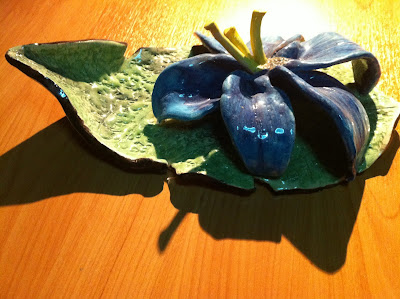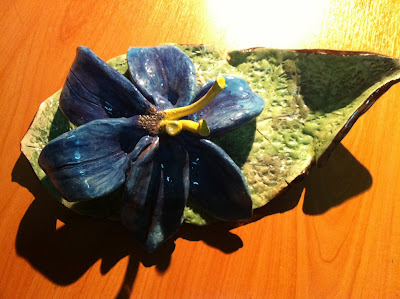a) Describe the subject matter of both works.
For Looking Ahead by Ng Eng Teng, it depicts truncated parts of body. The form is simplified and abstract, but the general shape of the hands and the facial expression could still be identified. The sculpture shows knee and part of thigh act as the base supporting the whole sculpture. The two forearms with hands could be easily identified. The absence of arm and body brings viewers’ attention to the forearm, the hands, and the head which is hold within the hand. The sculpture suggests a optimistic outlook as suggested in the artwork’s name. The expression on the face shows a rather relax and comfortable mood. The sculpture is supported by one forearm thus makes the sculpture looks rather unstable. This might due to the fact that the artist wants to convey that even though life might be hard but we must still look forward to the bright future ahead.
For Growth by Han Sai Por, it consists of 5 unique sculptures, each have different shapes. All these sculpture have smooth curve line, organic and naturalistic shapes. Also the texture is very smooth and the lines bring a sense of fluidity to the sculptures. Each of the five sculptures has different protrusions pointed at different angle. They seem to be struggling to survive and grow. There is like an unseen internal force exert on the sculptures. These five sculptures seem represent different stages of growing. As the forms are abstract and organic, it is hard to identify what the objects actually representing. However, it looks like different stages of plant growing from seed to young plant. As first stage, the first sculptures at the bottom left hand corner, the protrusion is bended at a low angle and the body seems like curl together. These might suggest that the seeds have felt the external force exert on it in the soil, which restrict its growing. However, as time passes, the seed start to grow and struggle to break free from the difficulties and unpleasant environment. This is depicted by the one of the sculptures at the left side and two at the right side of the series. Here, the protrusion are more and more round in shape and it is pointing more and more towards a higher angle which symbolize that the plant are growing taller and stronger. Finally, as depicted in the last sculpture at the top, the sculpture is standing up right with smooth curve and rounded angle. This shows that the seed has become a young adult plant which has been through growing period from a “baby” to an “adult”.
b) Discuss similarities and differences that exist in their treatment of forms and use of materials.
For Looking Ahead by Ng Eng Teng, the form is reduced to its simplest form. Different part of the body is been examined individually and reorganized to put it into composition. Most of the body part is been reduced to its basic shape or been removed from the composition – such as the torso, the arm and the legs. However, the elements of the sculpture still can be easily identified as the essences of the elements are still kept, such as the hands and the expression of the face.
However, for Growth by Han Sai Por, the forms are been abstracted and highly reduced to its basic organic shapes. The objects depicted by the sculptures could not be told by the viewers. The five sculptures exist individually yet they coincide with each other due to resemblance in their forms.
Both the artworks depict the form using smooth curve, which gives the artworks a sense of fluidity. Also, both of the artworks appear to be more of less rounded as the forms are reduced to simplest form.
For the use of material, Looking Ahead is made of bronze. It thus gives the artwork a more textured surface and metallic feeling. The texture of bronze could still be seen and touched in the sculpture. This might further suggest that even the life might be hard, which show by the texture of the bronze left from sculpture, we still must look ahead to the future.
In terms of the material complement to the message the artist wants to convey, Han Sai Por did the same thing as well. Instead of using bronze, she uses marble. Han Sai Por uses marble to carve out smooth textured surface and fluid line. This might suggest to the tenderness of a baby, or a young plant.
c) In your opinion, which work would you choose to be displayed in Nanyang Girls' High Schoo as part of our permanent art collection and where will the chosen work be exhibited? Discuss with consideration given to the artist's background, repertoire of works, approaches to art etc.
In my opinion, Growth by Han Sai Por should be displayed in school. This is because that Han Sai Por concerns about the balance between nature and urban life. Through her artwork, she wishes to advocate people to stay away from war and conflict, and find back the purity and emotion we used to have when we lived as part of nature. To her, due to the high-technology we have today, we have forgotten about the importance of nature, the environment. She hopes that through her artwork, people will stop and ponder the correct way to live with. This value is what we need to teach the student in school as well. The students need to know the importance of environment and not to be over-relying on the technology. This habit should be instilled since young so that the students will learn to appreciate the beauty of nature and not be controlled by the hurry life in urban city.
Also, the sculpture depicts the different growing stages. As secondary student, they are at their most crucial stage of growth. They will start to face a lot of challenges and start to struggle with the life and school’s workload. Thus, with Growth displayed in school, the students will learn how to struggle with inner forces, inner belief and problems in life during their growing stages. Also, as the students most likely to have puberty at this stage, they will face a lot of physical, psychological and emotional changes, just like the different shape in the sculpture. Therefore, the Growth can represent the students and make the student more relate to the artwork.
However, Ng Eng Teng’s sculpture may seem to be more disturbing to the students and the students may feel uneasy about it. As Ng Eng Teng’s main theme is human condition, he experiment on moving around different body parts, recombination and make the sculpture appear in an unusual way. However, even though in Looking Ahead the sculpture contains a positive meaning, but the distortion in form make the sculpture less appealing to the students. Also, the subject matter might be too difficult for the students to understand as they are not mature enough yet.









